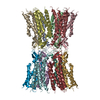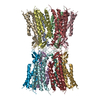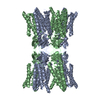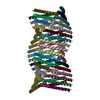+ Open data
Open data
- Basic information
Basic information
| Entry | Database: PDB / ID: 6uvs | |||||||||
|---|---|---|---|---|---|---|---|---|---|---|
| Title | Human Connexin-26 (Low pH open conformation) | |||||||||
 Components Components | Gap junction beta-2 protein | |||||||||
 Keywords Keywords | MEMBRANE PROTEIN / gap junction channel | |||||||||
| Function / homology |  Function and homology information Function and homology informationTransport of connexons to the plasma membrane / gap junction-mediated intercellular transport / gap junction channel activity involved in cell communication by electrical coupling / Oligomerization of connexins into connexons / Transport of connexins along the secretory pathway / gap junction assembly / connexin complex / gap junction / Gap junction assembly / gap junction channel activity ...Transport of connexons to the plasma membrane / gap junction-mediated intercellular transport / gap junction channel activity involved in cell communication by electrical coupling / Oligomerization of connexins into connexons / Transport of connexins along the secretory pathway / gap junction assembly / connexin complex / gap junction / Gap junction assembly / gap junction channel activity / endoplasmic reticulum-Golgi intermediate compartment / sensory perception of sound / transmembrane transport / cell-cell signaling / calcium ion binding / identical protein binding / plasma membrane Similarity search - Function | |||||||||
| Biological species |  Homo sapiens (human) Homo sapiens (human) | |||||||||
| Method | ELECTRON MICROSCOPY / single particle reconstruction / cryo EM / Resolution: 4.2 Å | |||||||||
 Authors Authors | Khan, A.K. / Jagielnicki, M. / Purdy, M.D. / Yeager, M. | |||||||||
| Funding support |  United States, 2items United States, 2items
| |||||||||
 Citation Citation |  Journal: Cell Rep / Year: 2020 Journal: Cell Rep / Year: 2020Title: A Steric "Ball-and-Chain" Mechanism for pH-Mediated Regulation of Gap Junction Channels. Authors: Ali K Khan / Maciej Jagielnicki / William E McIntire / Michael D Purdy / Venkatasubramanian Dharmarajan / Patrick R Griffin / Mark Yeager /  Abstract: Gap junction channels (GJCs) mediate intercellular communication and are gated by numerous conditions such as pH. The electron cryomicroscopy (cryo-EM) structure of Cx26 GJC at physiological pH ...Gap junction channels (GJCs) mediate intercellular communication and are gated by numerous conditions such as pH. The electron cryomicroscopy (cryo-EM) structure of Cx26 GJC at physiological pH recapitulates previous GJC structures in lipid bilayers. At pH 6.4, we identify two conformational states, one resembling the open physiological-pH structure and a closed conformation that displays six threads of density, that join to form a pore-occluding density. Crosslinking and hydrogen-deuterium exchange mass spectrometry reveal closer association between the N-terminal (NT) domains and the cytoplasmic loops (CL) at acidic pH. Previous electrophysiologic studies suggest an association between NT residue N14 and H100 near M2, which may trigger the observed movement of M2 toward M1 in our cryo-EM maps, thereby accounting for additional NT-CL crosslinks at acidic pH. We propose that these pH-induced interactions and conformational changes result in extension, ordering, and association of the acetylated NT domains to form a hexameric "ball-and-chain" gating particle. | |||||||||
| History |
|
- Structure visualization
Structure visualization
| Movie |
 Movie viewer Movie viewer |
|---|---|
| Structure viewer | Molecule:  Molmil Molmil Jmol/JSmol Jmol/JSmol |
- Downloads & links
Downloads & links
- Download
Download
| PDBx/mmCIF format |  6uvs.cif.gz 6uvs.cif.gz | 406.8 KB | Display |  PDBx/mmCIF format PDBx/mmCIF format |
|---|---|---|---|---|
| PDB format |  pdb6uvs.ent.gz pdb6uvs.ent.gz | 317.3 KB | Display |  PDB format PDB format |
| PDBx/mmJSON format |  6uvs.json.gz 6uvs.json.gz | Tree view |  PDBx/mmJSON format PDBx/mmJSON format | |
| Others |  Other downloads Other downloads |
-Validation report
| Summary document |  6uvs_validation.pdf.gz 6uvs_validation.pdf.gz | 985.2 KB | Display |  wwPDB validaton report wwPDB validaton report |
|---|---|---|---|---|
| Full document |  6uvs_full_validation.pdf.gz 6uvs_full_validation.pdf.gz | 986.1 KB | Display | |
| Data in XML |  6uvs_validation.xml.gz 6uvs_validation.xml.gz | 44.5 KB | Display | |
| Data in CIF |  6uvs_validation.cif.gz 6uvs_validation.cif.gz | 63 KB | Display | |
| Arichive directory |  https://data.pdbj.org/pub/pdb/validation_reports/uv/6uvs https://data.pdbj.org/pub/pdb/validation_reports/uv/6uvs ftp://data.pdbj.org/pub/pdb/validation_reports/uv/6uvs ftp://data.pdbj.org/pub/pdb/validation_reports/uv/6uvs | HTTPS FTP |
-Related structure data
| Related structure data |  20915MC  6uvrC  6uvtC M: map data used to model this data C: citing same article ( |
|---|---|
| Similar structure data |
- Links
Links
- Assembly
Assembly
| Deposited unit | 
|
|---|---|
| 1 |
|
- Components
Components
| #1: Protein | Mass: 26214.945 Da / Num. of mol.: 12 / Mutation: C211S, C218S Source method: isolated from a genetically manipulated source Source: (gene. exp.)  Homo sapiens (human) / Gene: GJB2 / Production host: Homo sapiens (human) / Gene: GJB2 / Production host:  |
|---|
-Experimental details
-Experiment
| Experiment | Method: ELECTRON MICROSCOPY |
|---|---|
| EM experiment | Aggregation state: PARTICLE / 3D reconstruction method: single particle reconstruction |
- Sample preparation
Sample preparation
| Component | Name: Connexin-26 Gap Junction Channel / Type: ORGANELLE OR CELLULAR COMPONENT / Entity ID: all / Source: RECOMBINANT | ||||||||||||||||||||
|---|---|---|---|---|---|---|---|---|---|---|---|---|---|---|---|---|---|---|---|---|---|
| Molecular weight | Value: 326 kDa/nm / Experimental value: NO | ||||||||||||||||||||
| Source (natural) | Organism:  Homo sapiens (human) Homo sapiens (human) | ||||||||||||||||||||
| Source (recombinant) | Organism:  | ||||||||||||||||||||
| Buffer solution | pH: 6.4 Details: NaCl was diluted from 1 M to 200 mM immediately before freezing. HEPES pH 7.5 buffer was diluted with MES pH 6.0 buffer thus adjusting pH to 6.4. | ||||||||||||||||||||
| Buffer component |
| ||||||||||||||||||||
| Specimen | Conc.: 0.6 mg/ml / Embedding applied: NO / Shadowing applied: NO / Staining applied: NO / Vitrification applied: YES | ||||||||||||||||||||
| Specimen support | Grid type: C-flat-2/2 | ||||||||||||||||||||
| Vitrification | Instrument: FEI VITROBOT MARK IV / Cryogen name: ETHANE Details: After application of sample to the C-flat holey carbon grid, sample was blotted with Whatman no. 1 filter paper for ~4s, blot force of 3, and 100 % humidity at 22oC. |
- Electron microscopy imaging
Electron microscopy imaging
| Experimental equipment |  Model: Titan Krios / Image courtesy: FEI Company |
|---|---|
| Microscopy | Model: FEI TITAN KRIOS |
| Electron gun | Electron source:  FIELD EMISSION GUN / Accelerating voltage: 300 kV / Illumination mode: SPOT SCAN FIELD EMISSION GUN / Accelerating voltage: 300 kV / Illumination mode: SPOT SCAN |
| Electron lens | Mode: BRIGHT FIELD / Nominal magnification: 130000 X / Cs: 2.7 mm |
| Image recording | Average exposure time: 10 sec. / Electron dose: 45 e/Å2 / Detector mode: SUPER-RESOLUTION / Film or detector model: GATAN K2 SUMMIT (4k x 4k) / Num. of grids imaged: 1 |
| EM imaging optics | Energyfilter name: GIF Quantum LS / Energyfilter slit width: 20 eV |
| Image scans | Movie frames/image: 25 |
- Processing
Processing
| EM software |
| ||||||||||||||||||||||||||||||||||||||||||||||||||
|---|---|---|---|---|---|---|---|---|---|---|---|---|---|---|---|---|---|---|---|---|---|---|---|---|---|---|---|---|---|---|---|---|---|---|---|---|---|---|---|---|---|---|---|---|---|---|---|---|---|---|---|
| CTF correction | Type: PHASE FLIPPING AND AMPLITUDE CORRECTION | ||||||||||||||||||||||||||||||||||||||||||||||||||
| Particle selection | Num. of particles selected: 49952 | ||||||||||||||||||||||||||||||||||||||||||||||||||
| Symmetry | Point symmetry: D6 (2x6 fold dihedral) | ||||||||||||||||||||||||||||||||||||||||||||||||||
| 3D reconstruction | Resolution: 4.2 Å / Resolution method: FSC 0.143 CUT-OFF / Num. of particles: 25236 / Symmetry type: POINT | ||||||||||||||||||||||||||||||||||||||||||||||||||
| Atomic model building | Protocol: OTHER / Space: REAL / Target criteria: Model-map cross correlation Details: Initial local fitting was done using UCSF Chimera. Multiple rounds of automated (Phenix) and manual (Coot) model building were performed. The model was validated in Molprobity(part of Phenix ...Details: Initial local fitting was done using UCSF Chimera. Multiple rounds of automated (Phenix) and manual (Coot) model building were performed. The model was validated in Molprobity(part of Phenix package). Model-map cross correlation score as well as EMRinger score were obtained in Phenix. RMSD values for C-alphas were calculated in UCSF Chimera. |
 Movie
Movie Controller
Controller











 PDBj
PDBj